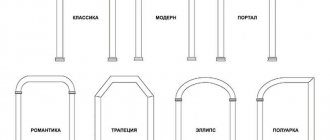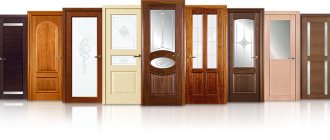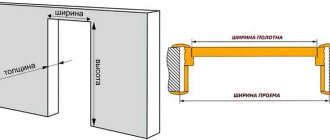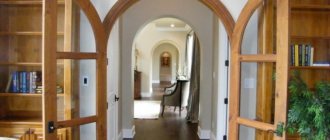GOST requirements for standard doorways
The dimensions of the interior door (door block) must strictly correspond to the dimensions of the opening in the wall between the rooms. In fact, it is the opening parameters that are prescribed in construction standards and GOSTs. And in accordance with them, you already have to select the thickness and width with height for the door frame and the door leaf inside.
If you are creating a unique designer interior in a private house, then the doors to the rooms can be made whatever you want. It is only necessary, at the project preparation stage, to provide openings in the partitions and load-bearing walls of the required sizes. But then door products will have to be ordered according to individual parameters for more money than standard options.
When creating an exclusive interior, do not forget that a door can complement the style if you approach the issue correctly
With city apartments the situation is fundamentally different. All of them are built according to standard design solutions, in which openings for interior doors are initially laid out to standard sizes. And in the vast majority of cases, expanding this hole is prohibited. Here it remains to select the door design only according to existing realities. And knowing the requirements of GOST, choosing a door in a store will be simpler and more error-free.
What is the door structure made of?
Marking of interior doors
When choosing an electric generator or a submersible pump for dirty water, you have to carefully study many parameters in the technical data sheet for this equipment. The power of the unit, productivity, and other quantities are important there. With an internal door everything is much simpler. The accompanying documentation indicates a set of numbers and letters that fully describe the width and height, as well as the design features of the product. Based on their design and method of opening, door blocks are divided into several main types:
- “G” is a blank wooden panel.
- “O” – canvas with glass insert.
- “Rp” or “Rl” – right or left swing door.
- “K” or “P” – swinging or sliding structure.
Design options for interior doors
In addition to these letters, the marking also indicates:
The above standard contains a table that lists the standard sizes of interior doors. More precisely, the reference dimensions of openings in walls and partitions are indicated there. It is these standard sizes that door block manufacturers start from. According to them, the height of the opening can be 1870, 2070 or 2370 mm, and the width from 710 to 1950 mm.
| Brand | Dimensions, mm | |||
| Box | Canvas | |||
| Height | Width | Height | Width | |
| 21-7 | 2071 | 670 | 2000 | 600 |
| 21-8 | 2071 | 770 | 2000 | 700 |
| 21-9 | 2071 | 870 | 2000 | 800 |
| 21-10 | 2071 | 1170 | 2000 | 900 |
| 21-12 | 2071 | 1170 | 2000 | 1100 |
| 21-13 | 2071 | 1272(1298) | 2000 | 1202(1204) |
| 21-15 | 2371 | 1472(1498) | 2300 | 1402(1404) |
| 21-19 | 2371 | 1872(1898) | 2300 | 1802(1804) |
Rules for measuring door openings
Before selecting the door size, it is necessary to accurately measure the parameters of the wall opening into which the door block will be installed.
To take measurements you will need a construction tape. Measurements are taken at least at two different points. It is recommended to do them several times, adjusting the location of the tape measure. Of the obtained values, you need to focus on the smallest ones.
The standard wall opening for interior doors is measured at both jambs. The dimensions of the passage width must be taken in two places: from above at a distance of approximately 40 cm from the lintel, from below at a similar distance from the floor base. You can additionally take measurements in the center of the passage.
It is imperative to measure the thickness of the wall itself in which the opening is located. The measurement is taken on each side in at least two different places.
In addition to measuring the height, width of the passage and wall thickness, it is imperative to check for geometric deviations in the end walls of the opening, since after installing the door block, the door leaf must be positioned strictly vertically on the sides and strictly horizontally on top.
To do this you need a building level or level. You can also use a regular plumb line (rope with a weight) to measure the vertical of the side walls. If significant deviations are detected, the wall surfaces must be leveled, and small ones, after installing the doors, will be sealed with construction foam or mortar and covered with decorative trims.
Dimensions and thickness of the canvas
The width and height of the door leaf are usually made 70 mm smaller than the dimensions of the door along the outer perimeter. 30–35 mm on each side goes to the box (frame). But there may be other options that are far from these standard values. Manufacturers are free to choose the dimensions of the product parts themselves in accordance with the design and materials from which it is made.
Building codes recommend the following sizes of interior doors with frames according to the width of the door being opened:
- for the kitchen – 70 cm;
- for the bedroom and other rooms – 80 cm;
- for the living room - double-leaf model 120 cm;
- for the bathroom – 60 cm.
Typical sizes of interior doors for different rooms
The standard height in all cases is assumed to be within the range of 1800–2000 mm, and the thickness of the canvas is 30–40 mm. At the same time, it is recommended to install doors in a bathroom or bathroom that are a little thicker and with a more moisture-resistant coating than in ordinary rooms.
How to correctly measure the height of doors with a threshold
What to focus on
First of all, remember: there are standards for interior and exterior doors. In the Soviet Union there was GOST 6629-88, which is still alive today, but now DIN 18100, DIN 18101 and DIN 18102 have been added to it, which already takes into account the dimensions of the opening taking into account European requirements, as well as standards for iron doors.
Currently working GOST 6629-88..
If the documents on the doors indicate that they were assembled according to some technical specifications (TU), and not according to generally accepted GOSTs, be careful. The technical specifications are developed by the manufacturer himself and they are only distantly related to standards, therefore, sizes can vary over a fairly wide range.
Dimensions of door blocks made according to technical specifications.
Interior doors
If you live in an apartment or house with ceilings up to 2.7 m, then the standard opening height often fluctuates around 2 m, with a tolerance of about 100 mm in one direction or another.
General installation diagram of interior doors.
The dimensions of openings in residential premises with high ceilings can reach up to 2.3 m. Anything higher, for example arches, does not fall under the generally accepted standard and belongs to the scope of individual orders.
There is one more nuance. Block houses, that is, brick, cinder block, foam concrete, and so on, are considered stable. Shrinkage in such buildings is minimal and lasts a maximum of a couple of years. This means that you can leave a gap of 10 - 15 mm around the perimeter of the door block and this will be quite enough.
Wooden houses are a completely different matter. For example, in log cabins, the shrinkage of a house lasts at least 3 years, and if the forest is poorly dried, then shrinkage can take 7–10 years.
Therefore, a gap of at least 30 - 50 mm must be left above the door frame. This gap is filled with foam and closed with platbands, but if it is not there, the frame can become distorted and even crushed.
Dimensions of openings and door blocks according to DIN 18100 – 18102.
To select a door, you must first of all focus on the size of the door leaf. If you follow our standards, the width of the leaf for interior doors starts from 600 mm and ends at 900 mm, graduated in increments of 10 cm.
In addition, narrow doors are still produced for small apartments and technical rooms; as a rule, they are installed on bathrooms.
The width of the canvas here is 550 mm and the height is 1900 mm. They are included in the standard, but they are not particularly popular, so the assortment there is “poor”.
Doors with a leaf width of 60–70 cm are usually installed in the kitchen and services; for rooms it is better to choose a leaf with a width of 80–90 cm.
The height of the installed frame with the door leaf and threshold.
Many owners often get burned by imported doors. To tell the truth, the single European standard is a beautiful myth; it practically does not concern doors. In the vastness of the former Soviet Union and the camp of the socialist camp there is more order, here the goods are made according to the above-mentioned GOSTs.
The Germans and Spaniards also adhere to our standards, but the French make doors 10 mm narrower than everyone else’s, that is, 690 mm, 790 mm and 890 mm.
Reputable Italian manufacturers are more focused on our market, but they are often counterfeited, so don’t be lazy, take a tape measure and measure the door block, you will agree that it will be a shame to pay a lot of money for a supposedly Italian thing that then won’t fit in or, on the contrary, will “dangle” in the doorway.
A selection of sizes for the most common doorways.
In addition to the height and width of the doorway, you also need to take into account the thickness of the walls and the thickness of the doors themselves. The standard thickness for interior partitions is 75 mm, but if the opening is made in a load-bearing wall, then the thickness there can reach half a meter or more.
The maximum thickness of a serial door block is 128 mm. Ideally, the door should be mounted in the center of the opening, but on thick walls it will be necessary to install additional strips on both sides.
As an option, you can install the door block along any edge and cover it with platbands on one side, and instead of extensions, on the other side, arrange slopes and cover the non-joint with a self-adhesive strip.
The width of the installed frame with the door leaf.
Interior door leaves have several thickness gradations:
- Lightweight hollow structures are made from 20 to 40 mm thick;
- Standard MDF doors are 35 - 40 mm;
- Wooden sheets with quarter grooves 35 – 45 mm;
- Completely natural wood without sampling 45 – 55 mm.
Entrance doors
Every year the size of the opening for the front door moves further and further away from fixed standards. And if the owners of city apartments are forced to adapt to the finished opening, then in private houses each owner has his own views, because often the front door is made to a specific order and changes extremely rarely.
If we talk about standards, the height here is no different from the interior version, that is, from 2000 mm to 2300 mm.
But the minimum width of a doorway for an entrance door starts from 900 mm. An exception is made only for wooden panels, which can be 800 mm.
But entrance doors are not only for apartments or houses; there are also doors for entrances, offices, small shops, etc. In these cases, the width of the opening can be unpredictable, but there is a way out.
Dimensions of single and double doors and openings.
According to the standard, the minimum for the entrance door you choose cannot be less than 80 cm, the maximum for single-leaf structures is 90 cm.
If the opening is wider, then double-leaf structures come next. They, in turn, can be equal-sized and unequal-sized, or as they are also called “one-and-a-half”.
Equal-sized structures, that is, those doors where both leaves are the same size, are often installed on wide openings of administrative buildings; for entrances and private houses, lorry-and-a-half doors are usually chosen, but they also have their own standardization:
(Main sash width + auxiliary sash width)
- 800 mm + 300 mm;
- 800 mm + 400 mm;
- 800 mm + 800 mm;
- 900 mm + 500 mm;
- 900 mm + 900 mm.
Double metal doors to the apartment with different doors.
What it looks like in practice
When installing doors there are 3 main questions:
- How the doors will be installed;
- What size should the door block be?
- What fittings and components are needed.
Entrance doors for apartments and private houses in our country are installed only with swing doors. Interior ones can also be folding and sliding. In addition, the doors can open to the right or left.
Measuring a doorway is carried out according to certain rules, so the width and height are measured at a minimum of 3 points and the smallest value is selected, and the depth (wall thickness) is measured at a minimum of 6 points and the largest value is selected.
Three parameters when taking the dimensions of a doorway.
According to the rules, the width of the doorway should be 60 - 100 mm greater than the width of the door leaf, and the height should be 60 - 80 mm greater.
Here a lot depends on the thickness of the box slats. So an MDF box on average has a thickness of about 25 mm, and wooden jambs can reach 50 mm.
A gap of 5 mm is left between the door leaf and the frame on the entrance doors around the perimeter. On interior doors without thresholds, 3 mm is left on top and sides, and the gap between the door leaf and the finished floor level is 20 mm.
Regardless of whether you are installing entrance or interior doors, the gap between the frame and the opening must be at least 10 mm.
Polyurethane foam is blown into this gap and if the house structures shrink, the foam will compensate for everything and you won’t even notice it. Otherwise, the frame may warp and the door will jam.
For example, we will take a kitchen door leaf with a width of 70 cm and a height of 2 m; let the thickness of the frame slats be 25 mm. With these parameters, we need to add minimum tolerances on all sides:
- To get the internal height of the box to the top crossbar, we add 20 mm of the bottom gap and 3 mm from the top to the height of the canvas. Plus the thickness of the box strip is 25 mm and the minimum gap between the box and the opening is 10 mm. In total we get 2000 + 20 + 3 + 25 + 10 = 2058 mm. (height of the doorway);
- The width is calculated in the same way. In our case, to 700 mm of the door leaf, you need to add a gap of 3 mm between the frame and the door, plus a 25 mm frame stand, plus a 10 mm installation gap. But do not forget that the box has 2 vertical posts, accordingly all these data are multiplied by 2. Total: 700 + (3 + 25 + 10) x 2 = 776 mm;
- Through simple arithmetic calculations, we found that for a kitchen door measuring 2000x700 mm, a doorway of 2058x776 mm is not needed.
Standard box sizes
The width of the box should ideally completely match the thickness of the wall. If the door is thicker than the interior partition, it will be difficult to secure it in the opening. Plus, there will be unsightly gaps on the sides under the casing. In the opposite situation, when the wall is too thick, you will need to install additional additional elements (extensions).
Design of interior doors with extensions
Calculation of a doorway in a building under construction
If calculations are made in a room with a rough finish, it is necessary to take into account that as a result of finishing work, the parameters may change due to the floor covering:
- when laying linoleum - by 1 cm;
- on laminate flooring - 2 cm;
- when laying porcelain stoneware or tiles – up to 5 cm.
It is necessary to make significant adjustments to the calculation if a heated floor is to be installed. In the case where two types of flooring are connected at the junction of the threshold, the joint is closed with a presser foot, which will require an additional few millimeters of height.
Opening sizes
Typical dimensions of doors with frames and openings for them are described in GOST standards. House designers and door block manufacturers try to follow these standards to make it easier for builders to select materials. However, often constructed buildings have deviations in height or a slight slope.
How to measure a doorway correctly
An opening for an interior door that differs from the standard dimensions in domestic high-rise buildings is far from uncommon. When measuring it before going to the store for the door block, you should measure the width and height of the existing hole in the wall in several places at once. It will still need to be leveled strictly vertically. If you make an error in the measurements, then it is unlikely that the product will be installed in accordance with building regulations.
Necessary measurements for interior doors
How to reduce a doorway
If, as a result of measurements, you determine that your house has a non-standard passage, then you will have to reduce it. The required work depends on the depth of the atypical opening:
- Up to 6.2 cm. Installation of a door frame and a mirror-mounted trim.
- 6.2-14 cm. Installation of the door frame, platband and trim 9 cm. The opening parameters are adjusted by changing the width of the trim.
- 14-20 cm. Installation of the door frame, platband and trim 15 cm. To achieve the desired parameters, the trim is sawn and processed using a chisel.
- 20-23 cm. Installation of the door frame, platband, 9 cm extensions on the right and left sides of the opening.
- 23-29 cm. Installation of the door frame, platband, 9 cm extension + 15 cm extension. In this case, the extensions are installed symmetrically on each side of the frame.
- 29-34 cm. Installation of the door frame, platband and extension 15 cm on the right and left sides. The required parameters are achieved by changing the width of the extensions - they are also sawn to the required sizes.
Doors with hidden frame
Owners who want something unique in the interior often refuse standard models and prefer to install doors with a hidden frame. In these blocks, the door leaf is flush with the surface of the wall, and there are no platbands as such. The dimensions of interior doors of this design are selected according to the same scheme as ordinary ones. Only in thickness they should ideally correspond to the parameters of the interior partition, so as not to protrude from it even by a centimeter.
How to correctly calculate the required dimensions for a door with a hidden frame
How to measure a doorway correctly
The partition in the interior partition, intended for installing a door, is called a door. In standard apartments it has standard sizes. However, you can always expand or narrow the doorway to accommodate the planned door.
You need to measure a doorway in three parameters: width, height and thickness.
The width of the opening should be measured along a horizontal line from edge to edge.
Opening height. There are two points here. The interior door can be installed both before finishing the floor and after finishing. Both options have the right to be implemented. If the door is planned to be placed on a subfloor, then the height of the opening is measured from the subfloor to the top of the opening without gaps. If the door is placed on a finished floor finish, then you can take into account that the frame should be 5 mm apart if the finish is floating (laminate, board) and 2-3 mm if the finish is monolithic (tiles). Usually this gap is taken into account when installing the door and it does not affect the height of the purchased frame.
Opening thickness . This value is needed to purchase extras. If the opening thickness is 75 mm, then this is the width of a standard box and no additional additions are needed.
Examples of calculating the proportionality of door frames and passages into rooms
To correctly calculate the dimensions of the door, you need to measure the opening in several places with a tape measure and select the minimum figure for width and height. Just before measuring anything, you should completely clear the end of the wall of any construction debris.
Necessary measurements for installing the door leaf
Height of openings for interior door structures
In apartment and private buildings with ceilings no more than 2.7 m high, the height of the doorway usually varies within 2 m plus/minus 10 cm. In rooms with high ceilings, the opening for installing an interior door can reach 2.3 m. Openings, including arched ones that are higher than this indicator are not considered standard. Doors for them will already be manufactured as an individual order.
Brick and block buildings are considered to be stably stable; minimal shrinkage is allowed in them over several years. Therefore, it is recommended to increase the standard height of the doorway by 1-2 cm, taking into account future shrinkage. In wooden houses, the shrinkage rate is much higher, and the process takes about 3 years or more. During construction, it is strongly recommended to add 3–5 cm to the standard height of the door portal as a gap above the frame, which is subsequently foamed with polyurethane foam. The absence of such a reserve during shrinkage provokes a skew of the interior door, which will not be able to fully close and open.
Doors to order
Factories offer a wide range of interior doors with frames and fittings, including non-standard options. But there are cases where manufactured products do not correspond to the existing opening. In this case, you can adjust it by increasing or decreasing the height and width to the required level. An alternative solution is to order a structure with non-standard dimensions.
The cost of making custom doors will be higher compared to purchasing finished products. But this will allow you to realize interesting ideas. For example, you can install compartment doors.
How to measure an opening
If the door has a threshold, the length of the opening can be calculated by summing the height of the threshold with the parameters of the panel, frame and mounting seam.
Rice. 7. Measuring the width of the opening
Fig.8. Determination of indicators with and without a threshold
According to the standards, it is not difficult to find out the width of the panel. For a 90-centimeter opening, a canvas 80 cm wide is suitable. This can be calculated as follows: 90-15*2-30*2= 81 cm, and the extra centimeters will be masked by the platbands.
When determining the dimensions, it is better to take into account the gap that will remain between the panel and the box. But this figure is 1-2 millimeters, so when making approximate calculations it can be ignored.
Choosing a door by opening size
So, we have the dimensions of the doorway, how to choose the right interior door. Here's a little cheat sheet to help you. The gaps should be the following values
- The gap between the canvas and the box should be 3 mm on each side;
- Between the canvas and the finished floor 10 -15 mm;
- Between the box and the subfloor 0 mm;
- Between the box and the finished floor is 4-5 mm;
- The installation gap between the frame and the opening is 20 mm on all sides except the threshold (if there is one);
- The installation gap between the door threshold and the subfloor is 0 mm.











